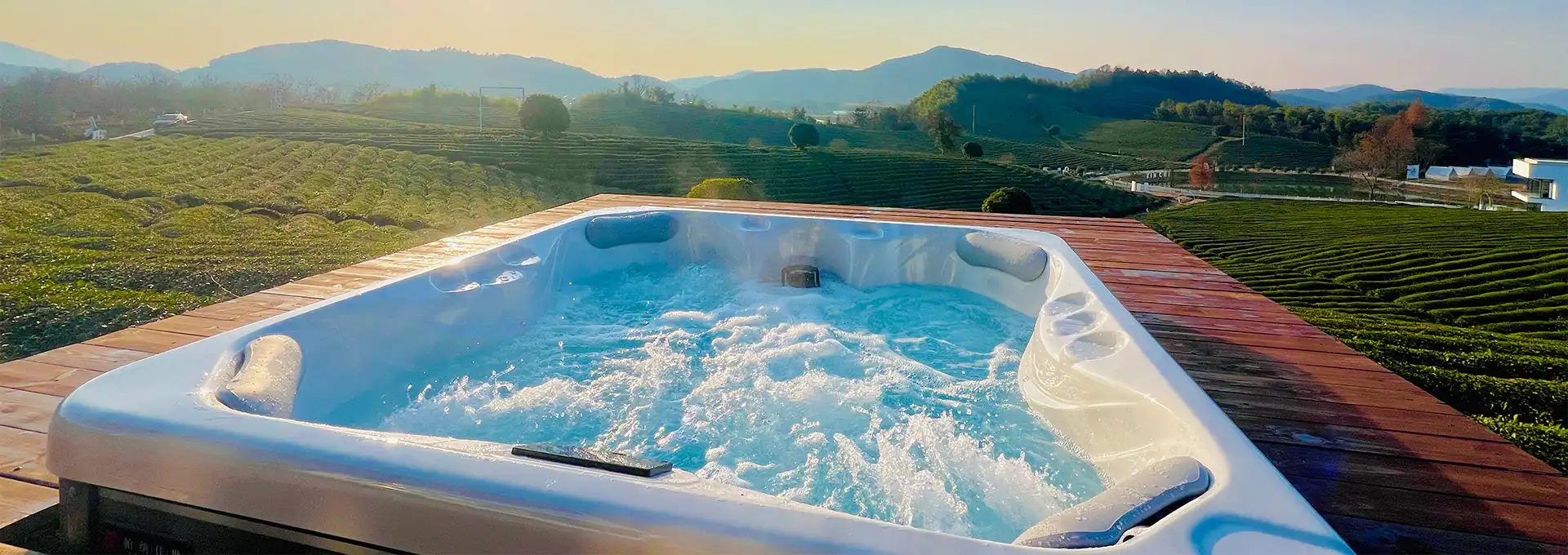What Size Sevice Does a Large Hot Tub Require?
2025-04-28 10:18:10
When it comes to installing a large hot tub, one of the most pivotal considerations is icing that you have the applicable electrical service to power it safely and efficiently. A large hot hogshead generally requires a devoted electrical circuit with sufficient amperage to handle its power demands. In this blog post, we'll explore the colorful factors that determine the size of electrical service demanded for a large hot hogshead and give you with precious perceptivity to help you make informed opinions for your installation.
What are the electrical requirements for a large hot tub?
Voltage and amperage considerations
Large hot tubs generally require a 220-240 volt electrical service, which is more powerful than the standard 110-120 volt household outlets. This higher voltage is necessary to power the multiple pumps, heaters, and other components found in larger hot tubs. The amperage requirements for a large hot tub can vary depending on its specific features and size, but typically range from 40 to 60 amps. It's essential to consult the manufacturer's specifications for your particular model to determine the exact electrical requirements. Keep in mind that some high-end large hot tubs may even require up to 100 amps of service to accommodate advanced features like multiple jet pumps, powerful heaters, and sophisticated control systems.
Circuit breaker and wire sizing
When installing a large hot tub, it's crucial to use the appropriate circuit breaker and wire size to ensure safe and efficient operation. The circuit breaker size should match the amperage requirements of your hot tub, with common sizes being 40, 50, or 60 amps. The wire gauge used for the electrical service must also be properly sized to handle the amperage load safely. For example, a 50-amp circuit typically requires 6-gauge wire, while a 60-amp circuit may need 4-gauge wire. It's important to note that the wire size may need to be increased if the distance between the main electrical panel and the hot tub is significant, as voltage drop can occur over longer runs. Always consult with a licensed electrician to determine the appropriate wire size for your specific installation.
GFCI protection requirements
Ground Fault Circuit Interrupter (GFCI) protection is essential for large hot tubs to ensure user safety and comply with electrical codes. A GFCI device monitors the electrical current flowing through the circuit and quickly shuts off power if it detects any imbalance, which could indicate a ground fault. For large hot tubs, a separate GFCI breaker is typically required and should be installed in the main electrical panel or a subpanel near the hot tub. Some manufacturers may include built-in GFCI protection in their control systems, but it's still important to verify this with the manufacturer and ensure that the installation meets local electrical code requirements. The GFCI breaker should be rated for the same amperage as the hot tub's electrical service to provide adequate protection without nuisance tripping.
How much space is needed for a large hot tub installation?
Dimensions and weight considerations
When planning for a large hot tub installation, it's essential to consider both the dimensions and weight of the unit. Large hot tubs can vary in size, but typically range from 7 to 9 feet in length and width, with depths of 3 to 4 feet. These dimensions can accommodate anywhere from 6 to 8 adults comfortably. The weight of a large hot tub is another crucial factor to consider. An empty large hot tub can weigh between 800 to 1,000 pounds, while a filled hot tub can easily exceed 4,000 to 6,000 pounds when factoring in water and occupants. This substantial weight requires a solid, level foundation capable of supporting the load, such as a reinforced concrete pad or a specially designed deck.
Clearance requirements
Proper clearance around a large hot tub is essential for both safety and maintenance purposes. Generally, you should allow for at least 3 feet of clear space on all sides of the hot tub. This clearance provides easy access for maintenance, allows for proper ventilation of the equipment, and ensures that users can safely enter and exit the hot tub. Additionally, you'll need to consider overhead clearance, especially if you're installing the hot tub indoors or under a covered area. A minimum of 7 feet of vertical clearance is recommended to accommodate the hot tub cover when open and to provide adequate headroom for users. It's also important to ensure that there's sufficient space for the electrical panel and any additional equipment, such as pumps or heaters, that may be housed separately from the main hot tub unit.
Access considerations for delivery and installation
When installing a large hot tub, it's crucial to plan for the delivery and installation process. The path from the delivery truck to the installation site must be wide enough and free of obstacles to accommodate the hot tub's size. Typically, you'll need a clear path of at least 4 feet wide and 8 feet high to maneuver the hot tub into place. If the installation site is not easily accessible, you may need to consider alternative delivery methods, such as crane delivery. It's also important to ensure that any gates, doorways, or other potential bottlenecks along the delivery path are wide enough to allow the hot tub to pass through. In some cases, temporary removal of fencing or other obstacles may be necessary to facilitate delivery. Additionally, consider the turning radius required for the hot tub, especially if it needs to navigate tight corners or narrow passages during installation.
What are the water and plumbing requirements for a large hot tub?
Water capacity and filling considerations
Large hot tubs typically have a water capacity ranging from 400 to 600 gallons or more, depending on the specific model and size. When filling a large hot tub, it's important to consider the impact on your home's water supply and pressure. Filling such a large volume may take several hours and could temporarily affect water pressure in other parts of your home. It's advisable to fill the hot tub during off-peak hours to minimize disruption. Additionally, you'll need to factor in the weight of the water when considering the structural support required for your hot tub. Each gallon of water weighs approximately 8.34 pounds, so a 500-gallon hot tub will add over 4,000 pounds of weight when filled. This significant weight increase underscores the importance of a properly engineered foundation to support your large hot tub.
Drainage and water treatment systems
Proper drainage is crucial for maintaining and servicing a large hot tub. You'll need to plan for a suitable drainage system that can handle the volume of water when you need to empty the hot tub for cleaning or maintenance. This may involve installing a dedicated drain line or ensuring that the hot tub is positioned near an existing drainage point. Additionally, large hot tubs require robust water treatment systems to maintain water quality and hygiene. These systems typically include filtration units, pumps, and chemical treatment systems. The size and capacity of these systems should be proportional to the volume of water in your large hot tub to ensure effective water circulation and treatment. Many modern large hot tubs come equipped with advanced water treatment technologies, such as ozonators or UV sanitization systems, which can help reduce chemical usage and improve overall water quality.
Plumbing and pump requirements
The plumbing system for a large hot tub is more complex than that of smaller models due to the increased water volume and multiple features. Large hot tubs typically require multiple pumps to handle various functions, such as jet propulsion, circulation, and filtration. These pumps may range from 2 to 5 horsepower or more, depending on the hot tub's size and features. The plumbing system must be designed to handle the high water flow rates generated by these powerful pumps without creating excessive back pressure or noise. This often involves using larger diameter pipes and carefully planned pipe runs to minimize friction losses. Additionally, the plumbing system should incorporate adequate valves and unions to facilitate maintenance and repairs. It's also important to consider the placement of the pumps and other equipment, ensuring they are easily accessible for maintenance while also being protected from the elements if the hot tub is installed outdoors.
Conclusion
Installing a large hot tub requires careful consideration of various factors, including electrical service, space requirements, and plumbing needs. The electrical service for a large hot tub typically demands a dedicated 220-240 volt circuit with 40-60 amps capacity, proper wire sizing, and GFCI protection. Adequate space must be allocated not only for the hot tub itself but also for clearance, access, and supporting equipment. Plumbing considerations include water capacity, drainage systems, and robust pump setups. By understanding these requirements, you can ensure a successful installation that provides years of enjoyment and relaxation in your large hot tub. For more information on hot tub installations and our products, please feel free to contact us at info@iparnassus.com.
References
- Johnson, S. (2021). "Hot Tub Electrical Requirements: A Comprehensive Guide." Home Spa Monthly, 15(3), 45-52.
- Smith, A. & Brown, T. (2020). "Large Hot Tub Installation: Best Practices and Considerations." Aqua Living Magazine, 8(2), 78-85.
- Davis, R. (2019). "Electrical Safety for Outdoor Hot Tubs and Spas." National Electrical Contractors Association Journal, 92(4), 32-38.
- Wilson, E. (2022). "Water Treatment Systems for Large Capacity Hot Tubs." Pool & Spa Technology Review, 11(1), 62-69.
- Thompson, L. & Garcia, M. (2020). "Structural Considerations for Hot Tub Installations." Landscape Architecture Quarterly, 25(3), 105-112.
- Anderson, K. (2021). "Energy Efficiency in Large Hot Tubs: Balancing Performance and Consumption." Green Living Today, 7(4), 28-35.
Send Inquiry
Related Industry Knowledge
- How to Cool Down a Swim Spa?
- Will Medicare Pay for a Swim Spa?
- What Causes Low pH in Hot Tubs?
- Can a Swim Spa Be Salt Water?
- What is Needed to Install a Hot Tub Swim Spa Combo?
- What is cold plunge tub?
- Can you do water therapy in a hot tub?
- Do 4-Person Hot Tubs Have Smart Controls?
- How is 7 Person Swim Spa Different From a Regular Hot Tub?
- How Does a Swimming Pool with a Spa Work?



